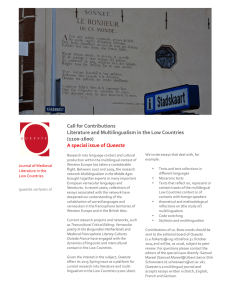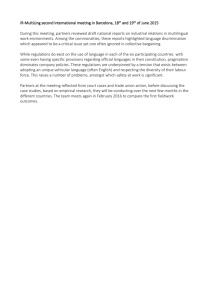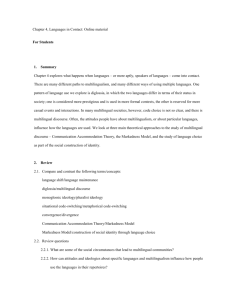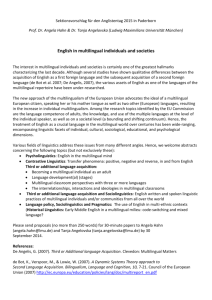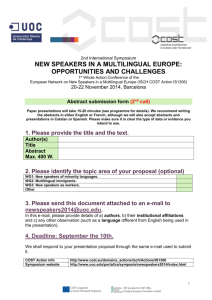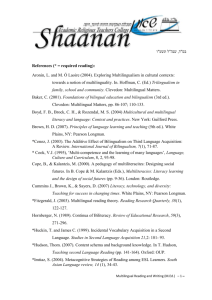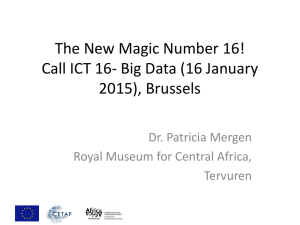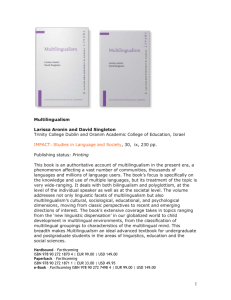Towards Rethinking Multilingualism and
advertisement
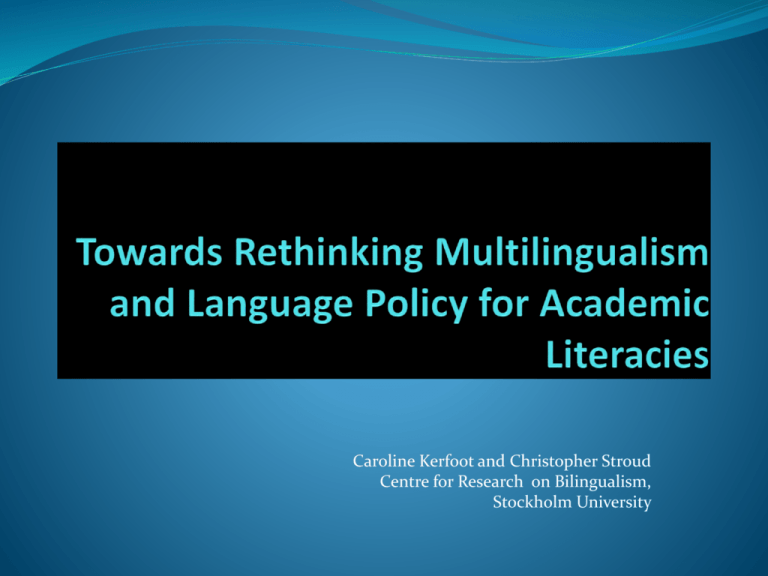
Caroline Kerfoot and Christopher Stroud Centre for Research on Bilingualism, Stockholm University Overview situate UWC within the broader tertiary education landscape argue for enaggement with complex new forms of linguistic and social diversity and a critical rethinking of the nature of multilingualism and language policy sketch how an alternative understanding of multilingualism for academic literacy may address some of the issues of power and voice that currently constrain epistemological access, that is, “access to the knowledge that universities distribute” (Morrow, 2007, p. 18), and consequently the transformation of HE. suggest a policy development process that moves from microinteraction to macro-structure 2 Change in post-1994 South African higher education a constant state of institutional and programmatic change since 1994 stasis or unwelcome continuities with the apartheid past (Badat, 2009) but at the same time innovations underway which place South Africa in the "forefront of higher education and transformation discussion" (Soudien, 2011, p. 20). address not only issues of social inclusion and conceptual access but also critical new approaches to the mediation and production of knowledge. 3 The South African Tertiary Landscape • High levels of poverty and continuing patterns of historical disadvantage, failures of the primary school system, and the inability generally of many state institutions to cater to the needs of the population, will continue to dominate sociopolitical development for the foreseeable future. • Recent statistics show that on all socio-economic measures, South Africa has regressed significantly in the years since the first free elections in 1994 (Marais, 2011). 4 Challenges: SA education system and international benchmarks International PIRLS literacy study ( 2006, 2011) South Africa came last out of 38 countries after countries like Morocco, Indonesia and Iran. Around 80% of South Africa’s Grade 4 and Grade 5 learners attained not even the most basic reading literacy, the ‘low’ benchmark, as against 6% internationally. And only 2% of South African learners reached the ‘high’ benchmark. (Baer et al. 2007) HSRC study of the Language and Mathematics Skills of Grade 8 Learners in the Western Cape in 2006 found that over 30% of learners in Grade 8 appear to have no more than emergent literacy skills and a further 24% can barely read or write. 5 The University of the Western Cape (UWC) • an “engaged university” with a vision statement “from hope to action • • • • through knowledge”. established in 1960 as a bilingual English/Afrikaans university college for people classified as “coloured”. “meant to produce the administrative corps for the bantustan and department of Indian Affairs and Coloured Affairs bureaucracies and to assist […] in the project of separate development” (Gordon, 1957, cited in Anderson, 2003, p. 34). Ten Bantustans (black African homelands) were established under apartheid in order to create ethnically homogeneous territories which could later serve as the basis for creating an "autonomous" nation state for each ethnic group. aligned itself to the national-liberation movement (Anderson, 2003) and created the country’s first nonracial, open admissions policy (UWC, 1982). committed to the admission of students from poor communities a very large proportion of students from educationally disadvantaged backgrounds 6 First Language/s Given By Students on Enrolment at the University of the Western Cape: A Comparison of 2001 and 2010 (UWC, 2011) First language/s Afrikaans given on Afrik. and Isi- Other Xhosa English Eng. Total Total % African % NOT student under- languages English number graduate enrolment first students language 2001 2010 1671 1039 3637 1182 2693 7806 (16%) (10%) (35%) (11%) (26%) (74%) 2737 931 4509 1449 7765 (15%) (5%) (25%) (8%) (42%) 10529 10,499 76% 18,294 79% (58%) 7 Reading the data • an increase in the number of students claiming English as a first language from 26% in 2001 to 42% in 2010, which is in line with broader studies of language shift in the Western Cape and South Africa more broadly (Anthonissen, 2009; Kamwangamalu, 2003; McCormick; 2002; Webb, 2002). • sociolinguistic reality is that the variety of English spoken in many homes and produced in classrooms differs from the variety of academic English expected at university, that many of these households remain in fact bi-, if not multilingual (Dyers, 2008; Plüddemann, Braam, October, & Wababa, 2004), • in some homes codeswitching itself could be considered a language variety (McCormick, 2002; Paxton, 2009). 8 So • A majority of students registered during the past decade could therefore be considered either bi- or multilingual to varying degrees. • Furthermore, it is safe to assume on the basis of South Africa’s performance on international and local benchmark tests (see Soudien, 2007) that a substantial number of these students did not have access to academic registers to any significant degree in any language. • Despite the obvious challenges thus arising from cohorts of highly bi/multilingual students entering the universities with palpable inadequacies in English academic literacy, “language” as an issue remains all but invisible in national assessments of the challenges facing HE generally (see Scott, 2009; Boughey, 2010). 9 A call for reconceptualisation of the University and the development of new epistemologies consonant with the complexities of “a post-racial world" : "what the University does in what it teaches, how it teaches and how it imagines learning might take place within it" (Soudien, 2011, p. 30) We believe that the majority of academic language and literacy development programmes conserve the status quo what is needed is a radical re-conceptualisation of the design of academic language and literacy programmes, and indeed of the very understanding that we have of multilingualism and its role in teaching and learning more generally 10 Thus the necessity of finding more radical and systematic ways to deal with the implications of diversity, especially linguistic diversity, for epistemological access emphasize mechanisms and processes for building “nonracial orientations to knowledge production” (Soudien, 2011, p.25) AND facilitating the voice and agency of students in the transformation of curriculum content and practice. This means that critical attention needs to be given to multilingualism as a transformative epistemology and methodology of diversity. 11 Our point of departure the success of transformation in South African tertiary education contexts such as UWC depends crucially on transforming students’ everyday encounters with teaching and learning. Fundamental here is the role of language, specifically the multiple languages which students bring with them into the academy. We argue this point from the perspective of the role multilingual repertoires play in the voice, power and agency of speakers (Alexander, 2003; Blackledge & Creese, 2010; Heller & MartinJones, 2001). Voice here is understood as the (structured) capacity to use multilingual semiotic resources to produce rather than merely reflect realities (Pennycook ,2001) and to achieve “semiotic mobility” (Blommaert, 2005), that is, to create meanings than can be taken up across social and, in this case, educational spaces. 12 A transformative epistemology of multilingualism for HE all available languages and semiotic resources are used and promoted in pursuit of learning encourages a questioning of monodiscursive, monolingual norms in education – be these in one or the other language. takes voice, rather than language, as a starting point (Bailey, 2007; Stroud, 2009), focusing on linguistic repertoires rather than languages (Block, 2003; Blommaert & Rampton, 2011), practices rather than proficiency (Canagarajah, 2007), translanguaging rather than codeswitching (Creese & Blackledge, 2010; García, 2007, 2009). resemiotisation which focuses on the “unfolding of meaning-making across practices, and enquires into its material consequences “(Iedema, 2003, p. 49) as fundamental to a reconceptualisation of HE language policy 13 Escaping the gridlock of monoglossia: Key questions what roles can language/multilingualism play in changing structures of academic privilege? what models and sets of strategies exist – or need to be developed– that can make this goal possible? 14 International research in academic literacies a change in emphasis from “text” to “practice” (Street 2004; Barton & Hamilton, 2000), a recasting of student identities from “apprentices” on the periphery of academic discourse communities to “agents” at the centre of meaning-making (Lillis & Scott, 2007). critical perspectives on academic development which go beyond induction into the norms of disciplinary communities, seeing meaning-making as a site of struggle and prising open spaces for a wider range of representational resources in teaching and learning, including those brought by students (Lillis & Scott, 2007). 15 Towards a Transformative Language Policy in Higher Education A priority must therefore be to reform curricula in ways that genuinely accommodate the diverse intake so that “teaching and design practices are aligned with the students’ legitimate learning needs” (Scott, 2009, p. 28). 1.) One important aspect of this is for language policies and practices for the tertiary education sector to address the mismatch between “the monolingual ethos and the ideology of English-medium tertiary education and the needs, identities and resources of multilingual students” (Preece & Martin, 2010, p. 3). In order to accomplish this, a crucial condition is the development of an understanding of language as practice that places at the centre people as actors engaged in “languaging” (Becker, 1995, cited in Pennycook, 2010). 16 2.) A second aspect is the need for a fundamental rethinking of the role of language and multilingualism in HE in terms of semiotic resources and repertoires for critical authorship and epistemological ownership. This entails a reconceptualisation of students as “walking” repertoires or portfolios of multiple codes and integrated semiotic resources available to be deployed for academic authority, agency and voice 17 Multilingual Repertoires as Resources for Epistemological Access Studies of academic writing in multilingual HE contexts, although few, indicate a range of creative translanguaging practices used by multilingual writers. South African studies illustrate the value of multilingual repertoires for conceptual understanding, critical engagement and voice emphasise the bidirectional nature of the impact of bilingual pedagogy on discipline-specific conceptual understanding and register development, as well as enhanced confidence, motivation and performance. use code-switching confidently and openly as a translanguaging strategy and pedagogic resource, scaffolding and deepening conceptual understanding in disciplinary subjects Further, accepting the pedagogic validity of translanguaging enables a different lens on the “intellectualisation” of African languages and can contribute to building academic registers in African languages through bottom-up processes in which students are co-creators of knowledge. 18 3.) A third key aspect would be that accounting for student diversity with the goal of enhanced voice and agency in knowledge-generating spaces entails working with the realisation that all discourse repertoires are inevitably social and ideological. This concern with knowledge-making also applies to multimodal forms of representation -- informed by new work on “emerging literacies” (Lea, 2007), especially those afforded by the interactive applications of Web 2.0. This work has illuminated new spaces of engagement which challenge traditional conceptions of sites of knowledge construction and the parameters of what counts as academic writing. 19 Expanding Meaning-Making Repertoires: Multimodality and Hypertextuality potential of a multimodal approach for addressing issues of equity and access in a context where the majority of South African students learn in a second or additional language interrogate legitimised “representational resources” (Kress, 1996, p. 18), or routinely accepted ways of using language and other forms of semiosis, in tertiary educational spaces which often, if unintentionally, privilege certain kinds of cultural capital and reproduce patterns of privilege (Thesen, 2001). 20 ”Resemiotisation” as fundamental to reconceptualising multilingually based academic transformation Along with the rapid development of technologies has come a blurring of the boundaries between “text”, mode, media and context, producing “new and unsettled genres” (Jewitt, 2008, pp. 255-56). Students work across sites of expression, continuously decontextualise and recontextualise texts, images and other semiotic forms (Jewitt, 2008; Thesen, 2007). A notion of resemiotisation which allows analysis of the ways in which “meaning-making shifts from context to context, from practice to practice, or from one stage of a practice to the next,” (Iedema, 2003, p. 41) provides the conceptual bridge that brings together these strands of research to articulate practices with multilingual resources: resemiotisation in multilingual contexts often also includes recoding into one or more languages or language varieties (Kerfoot, 2011). Example 21 Nurturing multilingual, multimodal repertoires: possibilities An array of downloadable podcasts either subtitled into the languages desired by students or recorded in two or more languages either by the same lecturer or an associate depending on the repertoires of the lecturer/s in question. Ideally multiple versions of lectures in different languages accessible at the press of a button. Translated course outlines, key readings, assignments and exam questions provided as a matter of course on e-learning platforms. A cohort of well-trained isiXhosa- and Afrikaans-speaking tutors with qualifications in the field of study to mark assignments written in the language or languages of students’ choice and also to teach students in tutorials. African language and Afrikaans speaking tutors available online at all times 22 Multilingual technical glossaries available online and through mobile learning devices along with instant translation. State interventions in allocating resources towards enabling instant translation in all South African languages through, for example, Google translate, would have immediate spin-offs in increased understanding of course content. Work on this is proceeding in isiXhosa and isiZulu Commissioning the translation of key texts in all fields, made available free as eBooks by institutions, reality is that students will have not have money for textbooks for the foreseeable future. Web technologies, enabling experts from different disciplines to work together at no cost and to engage in activities such as translate@thons. 23 Towards a new policy process Language policies and practices need to be located within wider debates over reshaping “disciplinary, policy, and pedagogy toolkits for addressing new times” (Luke, 2003, p. 134) and the kinds of local textual practices that can and should be forged in relation to larger social dynamics. In the context of UWC, we have argued that this should translate into a multilingual policy and practice based in a visionary leadership and investment in the kind of technological and human resources that will make possible transformative practices. This should radically increase the chances of epistemological access, inclusive dialogic pedagogies and ultimately academic success. 24 We suggest a policy process that begins by tracing micro-interactions in spaces of learning both formal and informal, physical and virtual, moves on to interrogate legitimate representational resources in these spaces and then, on this basis, promotes enabling institutional practices. Tracing processes of resemiotisation in this way from micro- to macrolevels enables us to move beyond language alone as the theoretical point of departure and to address the principle and possibility of social change itself (Iedema, 2001, 2009). Such a process might contribute to building new non-racial orientations to knowledge production and transforming teaching and learning. It might also change the vectors along which knowledge flows, transforming the material consequences of meaning-making beyond the academy. 25 References Bamgboṣe, A. (2000). Language and Exclusion: The Consequences of Language Policies in Africa. LIT Verlag Münster. Heugh, K., Benson, C., Yohannes, M. E. G., & Bogale, B. (2011). Implications for multilingual education: Student achievement in different models of education in Ethiopia. In T. Skutnabb-Kangas & K. Heugh (Reds), Multilingual Education and Sustainable Diversity Work: From Periphery to Center (pp. 239–). Routledge . 26 HE participation rate 1993 2009 Total students 473 000 837 779 Africans approximately 9% 12.8% coloured 13% 13,6% Indians 40% 50+ % whites 70% 60% Sources: Badat, 2009; Council on Higher Education 2004, 2009. 27 Mobilities and the nation/state multiple and intersecting mobilities seem to produce a more "networked" patterning of economic and social life, even for those who have not moved.... Mobilities are centrally involved in reorganising institutions, generating climate change... altering tourism and migration patterns, producing a more distant family life, transforming the social and educational life of young people and South. The human body and the home are transformed, as proximity and connectivity are imagined in new ways and often enhanced by communication devices…. Crucially the nation itself has been transformed by these mobilities as is the city. New economic and political geographies of "state rescaling" and urban restructuring "the image of political-economic space as a complex, tangled mosaic of superimposed and interpenetrating notes, levels, scales and morphologies (p. 3) has become more appropriate than the traditional Cartesian model of homogenous, self-enclosed and contiguous blocks of territory that has long been used to describe the modern interstate system" (Brenner, 2004,p. 66). Shift away from the "traditional, Westphalian model of statehood" based on nationalterritorial containers towards more "complex, polymorphic, and multiscalar regulatory geographies"(Brenner, 2004,p. 67) is fundamentally related to the emergence of complex mobility systems and their restructuring of both space and time. (Hannam et al, 2006, p. 2) 28 Scores voor wiskunde en lees- en schrijfvaardigheid (4de lj) Country Numeracy Literacy Tunesia 60,4 77,9 Mauritius 58,5 61,0 Morocco 56,4 67,6 Botswana 51,0 48,0 Uganda 49,3 58,7 Madagascar 43,7 54,7 Mali 43,6 51,8 Malawi 43,0 35,0 Senegal 39,7 48,9 Niger 37,3 41,1 Zambia 36,0 43,0 South Africa 30,2 48,1 29 Slaagpercentages (Westkaap 2004): lees- en schrijfvaardigheid Ex-Dept Grade 3 Grade 6 % of Prov Learners CED 97,8 82,9 20 HOR 81,5 26,6 14 DET 66,5 3,7 65 30 Slaagpercentages (Westkaap 2004): wiskunde Ex-dept Grade 3 Grade 6 CED 90,5 62,4 HOR 30,5 3,8 DET 12,0 0,1 31

